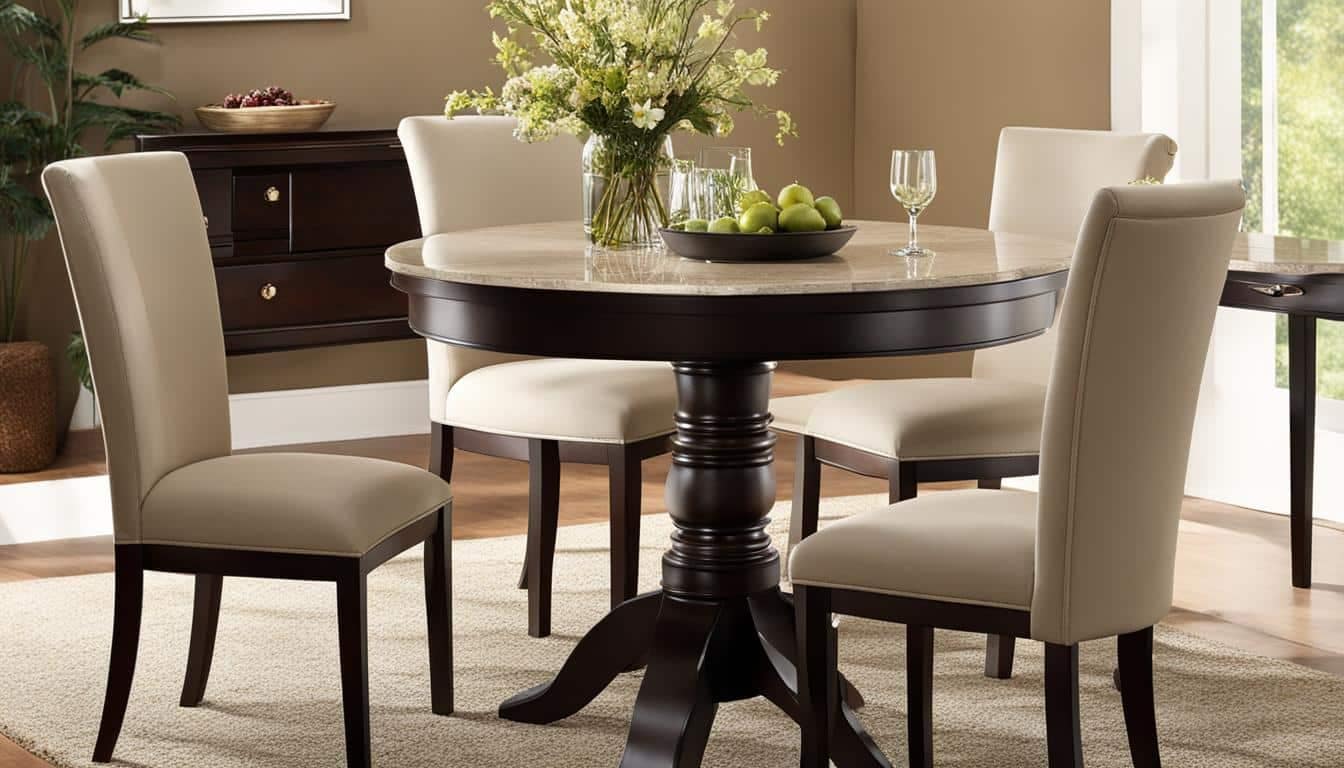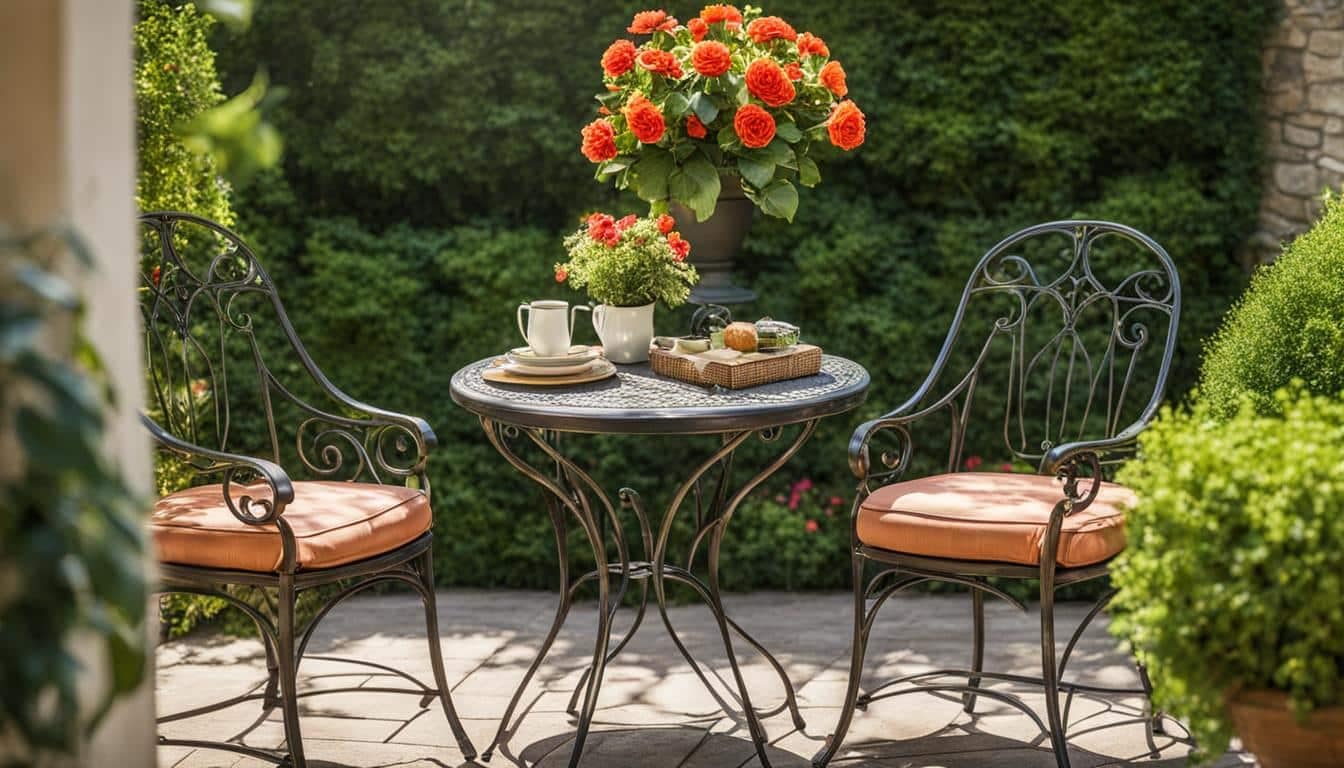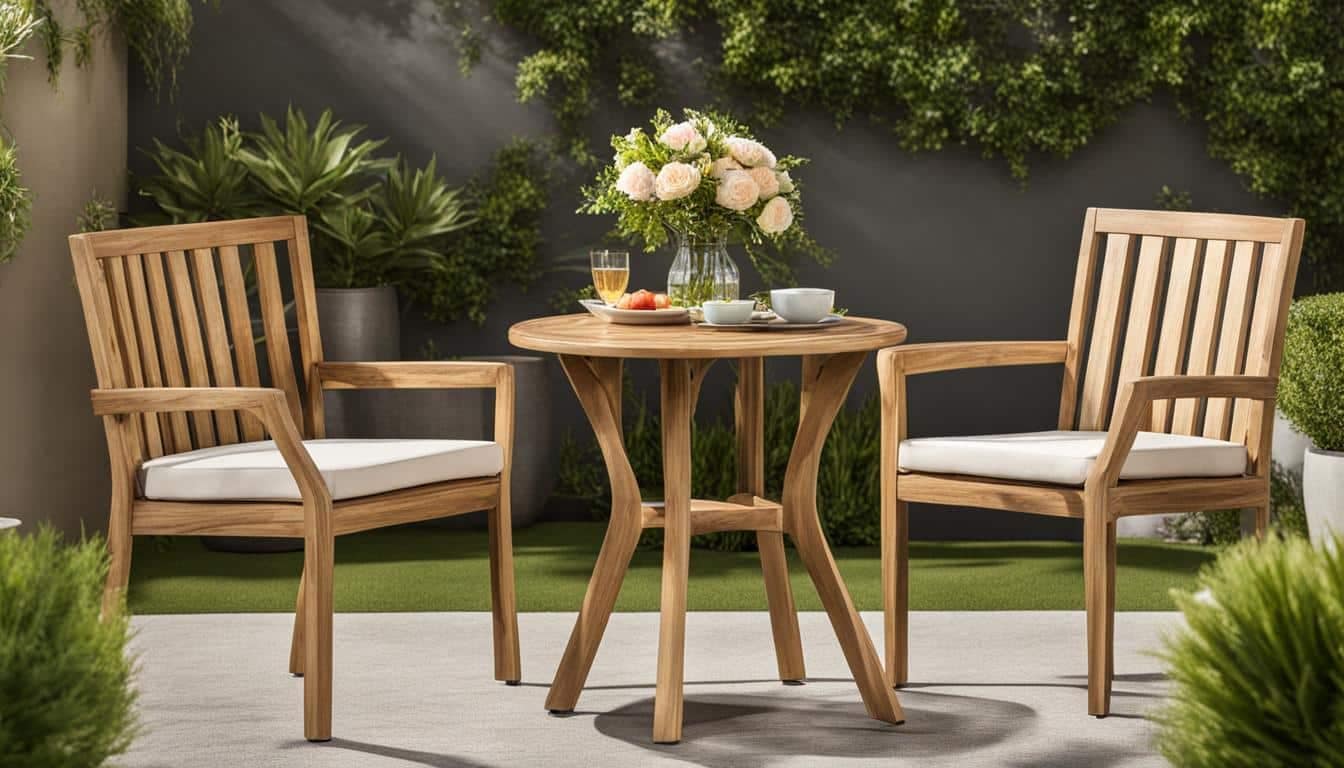Homeowners in the U.S. spent over $15 billion on outdoor furniture in 2020, and this figure is expected to grow through 2027. To ensure that you can enjoy your outdoor furniture for multiple seasons, it’s important to protect it from the elements. By following expert tips and ideas, you can maintain the durability and beauty of your wood outdoor furniture.
From anchoring your furniture to using covers, sealing wooden furniture with polyurethane, keeping it in the shade, and applying paste wax to metal and aluminum furniture, there are several methods you can employ to protect your wood outdoor furniture and extend its lifespan. Additionally, proper storage during the off-season and regular cleaning and maintenance are crucial for preserving the quality of your outdoor furniture.
Key Takeaways:
- Properly protect your wood outdoor furniture to extend its lifespan.
- Anchor your furniture and use covers to prevent damage during extreme weather conditions.
- Seal wooden furniture with polyurethane and apply protective coatings to enhance durability.
- Place your furniture in the shade and store it correctly during the off-season to prevent damage.
- Regular cleaning and maintenance are essential for preserving the quality of your outdoor furniture.
Anchoring Your Outdoor Furniture
If you live in an area prone to high winds, it’s important to take precautions to secure your outdoor furniture. By properly anchoring your furniture, you can prevent it from being damaged or blown away during severe weather conditions.
One effective method of anchoring is to stack and tie down chairs when they’re not in use. This helps to create a stable and secure arrangement that is less likely to be affected by strong winds. Additionally, closing umbrellas or bringing them indoors can prevent them from becoming projectiles during storms.
Another way to secure your outdoor furniture is by tying cushions to the furniture itself. This prevents the cushions from being blown away and keeps them in place even in windy conditions. Furthermore, you can provide additional protection by covering your furniture with tarps or using custom-made covers. These covers act as a barrier against rain, wind, and other elements, keeping your furniture safe and secure.
Here are some tips for anchoring your outdoor furniture:
- Stack and tie down chairs when not in use.
- Close umbrellas or bring them indoors during storms.
- Tie cushions to the furniture to prevent them from blowing away.
- Cover your furniture with tarps or custom covers for added protection.
By following these anchoring methods, you can ensure that your outdoor furniture remains secure and intact, even in inclement weather. Taking these simple steps will give you peace of mind and help extend the lifespan of your cherished outdoor furniture.
Applying Protective Coatings
Protecting your outdoor furniture with the right coatings is essential for ensuring its longevity and resistance to the elements. Here are some effective methods to apply protective coatings to different types of outdoor furniture:
Sealing Wooden Outdoor Furniture with Polyurethane
If you have wooden outdoor furniture, sealing it with polyurethane is a great way to protect it from the sun, moisture, and other environmental factors. Polyurethane forms a protective layer that helps to prevent water damage, fading, and warping. Before applying polyurethane, make sure to clean and sand the surface of the wood to ensure proper adhesion of the coating. Once the surface is prepared, apply the polyurethane evenly using a brush or a sprayer, following the instructions provided by the manufacturer.
Applying Paste Wax to Metal and Aluminum Furniture
Metal and aluminum outdoor furniture can benefit from the application of paste wax. The wax creates a protective barrier that helps to prevent corrosion and rust, keeping your furniture looking like new. To apply paste wax, start by cleaning the surface of the furniture to remove any dirt or debris. Then, use a clean cloth or applicator pad to apply a thin layer of wax. Allow the wax to dry according to the manufacturer’s instructions, and then buff it off with a soft cloth to achieve a smooth and glossy finish.
Using Protectant on Plastic Furniture
Plastic outdoor furniture is prone to fading and cracking when exposed to prolonged sunlight. To protect plastic furniture, you can use a protectant spray specifically formulated for plastic surfaces. This spray forms a protective layer that blocks harmful UV rays and prevents color fading and cracking. When applying the protectant, make sure to clean the furniture first to remove any dirt or grime. Spray the protectant evenly onto the surface, following the instructions provided by the manufacturer.
By applying these protective coatings to your outdoor furniture, you can ensure its durability and prolong its lifespan. Whether you have wooden, metal, aluminum, or plastic furniture, there is a suitable coating method to shield it from the elements and maintain its appearance.
Placement and Off-Season Storage
One of the simplest and most effective ways to protect your outdoor furniture is by placing it in the shade. By positioning your furniture under an umbrella or a shaded structure, you can minimize its exposure to direct sunlight. This helps to reduce the risk of sun damage, such as fading and cracking, and extends the lifespan of your furniture. Additionally, keeping your furniture in the shade ensures that it remains cool and comfortable, providing a pleasant outdoor experience for you and your guests.
During the off-season when you’re not using your outdoor furniture, it’s important to clean and store it properly. Start by thoroughly cleaning your furniture to remove any dirt, debris, or stains. Use a mild detergent and a soft brush or sponge to gently scrub the surfaces. Rinse thoroughly with water and allow the furniture to dry completely before storing it.
When storing your outdoor furniture, it’s best to keep it indoors or in a protected area, such as a garage or storage shed. This helps to shield the furniture from the elements, preventing damage from rain, snow, and extreme temperatures. If you don’t have indoor storage space, you can invest in furniture covers that are specifically designed to protect against moisture and UV rays. These covers provide an additional layer of protection during the off-season, keeping your furniture in good condition until it’s ready to be used again.
Tips for preventing mold or mildew growth on outdoor furniture:
- Ensure that your furniture is completely dry before storing it, as moisture can promote the growth of mold and mildew.
- Avoid stacking or tightly packing your furniture during storage, as this can restrict airflow and create a humid environment.
- Consider using moisture-absorbing products, such as silica gel packets or charcoal briquettes, to help keep the storage area dry and prevent mold growth.
- Regularly inspect your furniture for any signs of mold or mildew, such as black or green spots. If you notice any growth, clean it immediately using a mixture of water and white vinegar or a mildew cleaner.
By following these placement and storage tips, you can protect your outdoor furniture from the elements and ensure that it remains in excellent condition for years to come. Whether you’re enjoying a sunny day in the garden or storing your furniture during the off-season, taking these proactive measures will help prolong the life and beauty of your outdoor furniture.
Conclusion
Congratulations on taking the necessary steps to protect your wood outdoor furniture and extend its lifespan! By following these expert tips and best practices, you can ensure that your outdoor furniture remains in excellent condition for years to come.
In summary, anchoring your furniture during high winds, applying protective coatings, and storing it properly during the off-season are key to preserving its durability and beauty. Anchoring your furniture with custom covers and securing cushions will prevent damage during severe weather conditions.
Applying coatings like polyurethane and paste wax will safeguard your wood and metal furniture from the sun, water, corrosion, and rust. Placing your furniture in the shade and storing it indoors or in a protected area will further protect it from the elements and prevent mold or mildew growth.
Remember to perform regular cleaning and maintenance, such as removing dirt, reapplying protective coatings, and storing your furniture properly during the off-season. By following these key takeaways, you can enjoy your wood outdoor furniture year-round and create a welcoming and stylish outdoor living space.
FAQ
How can I secure my outdoor furniture?
You can anchor your furniture by stacking and tying down chairs when they’re not in use, closing umbrellas or bringing them inside, and ensuring that cushions are tied to the furniture. Once everything is anchored, you can cover your furniture with tarps or individual custom covers to provide further protection.
What protective coatings can I use for outdoor furniture?
For cushion fabric, you can use a spray-on sun and water shield to add a layer of protection against the elements. Sealing wooden outdoor furniture with polyurethane is important to protect it from the sun and bring out its natural beauty. When it comes to metal and aluminum furniture, applying a coating of paste wax acts as a protective barrier against corrosion and rust. For plastic furniture, using a protectant spray can prevent fading and cracking caused by prolonged sun exposure.
How can I protect my outdoor furniture from sun damage?
One of the simplest ways to protect your outdoor furniture is by placing it in the shade. This can be achieved by positioning it under an umbrella or a more permanent shaded structure. By reducing the exposure to direct sunlight, you can lower the risk of sun damage and extend the life of your furniture.
How should I clean and store my outdoor furniture during the off-season?
When you’re not using your outdoor furniture during the off-season, it’s important to clean it thoroughly and store it properly. Moisture and dirt left on outdoor furniture can lead to mold or mildew growth, causing damage over time. By cleaning your furniture and storing it indoors or in a protected area, you can prevent these issues and ensure that your furniture remains in good condition.








